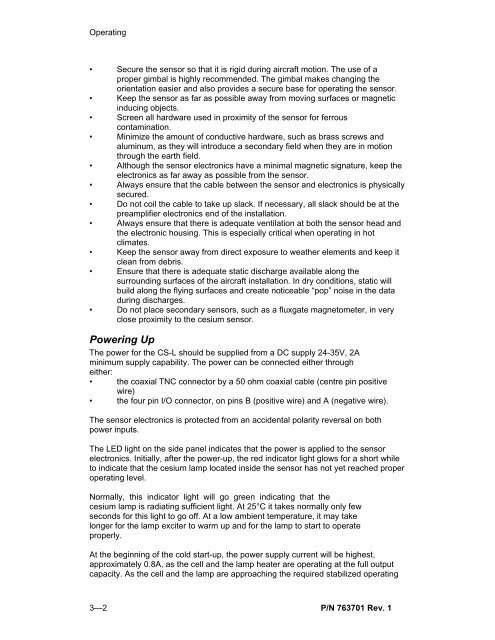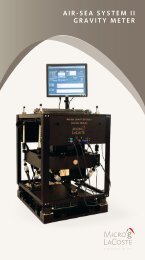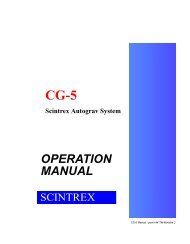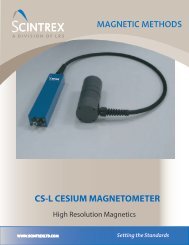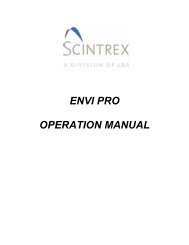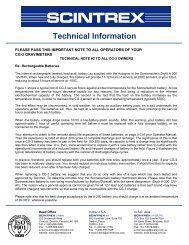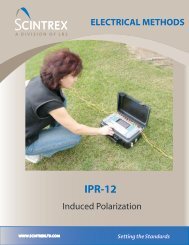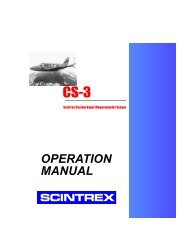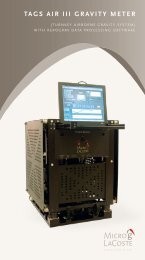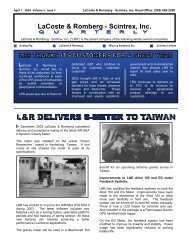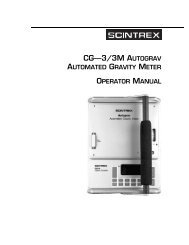CS-L Cesium Vapor Magnetometer Sensor OPERATION ... - Scintrex
CS-L Cesium Vapor Magnetometer Sensor OPERATION ... - Scintrex
CS-L Cesium Vapor Magnetometer Sensor OPERATION ... - Scintrex
Create successful ePaper yourself
Turn your PDF publications into a flip-book with our unique Google optimized e-Paper software.
Operating<br />
• Secure the sensor so that it is rigid during aircraft motion. The use of a<br />
proper gimbal is highly recommended. The gimbal makes changing the<br />
orientation easier and also provides a secure base for operating the sensor.<br />
• Keep the sensor as far as possible away from moving surfaces or magnetic<br />
inducing objects.<br />
• Screen all hardware used in proximity of the sensor for ferrous<br />
contamination.<br />
• Minimize the amount of conductive hardware, such as brass screws and<br />
aluminum, as they will introduce a secondary field when they are in motion<br />
through the earth field.<br />
• Although the sensor electronics have a minimal magnetic signature, keep the<br />
electronics as far away as possible from the sensor.<br />
• Always ensure that the cable between the sensor and electronics is physically<br />
secured.<br />
• Do not coil the cable to take up slack. If necessary, all slack should be at the<br />
preamplifier electronics end of the installation.<br />
• Always ensure that there is adequate ventilation at both the sensor head and<br />
the electronic housing. This is especially critical when operating in hot<br />
climates.<br />
• Keep the sensor away from direct exposure to weather elements and keep it<br />
clean from debris.<br />
• Ensure that there is adequate static discharge available along the<br />
surrounding surfaces of the aircraft installation. In dry conditions, static will<br />
build along the flying surfaces and create noticeable “pop” noise in the data<br />
during discharges.<br />
• Do not place secondary sensors, such as a fluxgate magnetometer, in very<br />
close proximity to the cesium sensor.<br />
Powering Up<br />
The power for the <strong>CS</strong>-L should be supplied from a DC supply 24-35V, 2A<br />
minimum supply capability. The power can be connected either through<br />
either:<br />
• the coaxial TNC connector by a 50 ohm coaxial cable (centre pin positive<br />
wire)<br />
• the four pin I/O connector, on pins B (positive wire) and A (negative wire).<br />
The sensor electronics is protected from an accidental polarity reversal on both<br />
power inputs.<br />
The LED light on the side panel indicates that the power is applied to the sensor<br />
electronics. Initially, after the power-up, the red indicator light glows for a short while<br />
to indicate that the cesium lamp located inside the sensor has not yet reached proper<br />
operating level.<br />
Normally, this indicator light will go green indicating that the<br />
cesium lamp is radiating sufficient light. At 25°C it takes normally only few<br />
seconds for this light to go off. At a low ambient temperature, it may take<br />
longer for the lamp exciter to warm up and for the lamp to start to operate<br />
properly.<br />
At the beginning of the cold start-up, the power supply current will be highest,<br />
approximately 0.8A, as the cell and the lamp heater are operating at the full output<br />
capacity. As the cell and the lamp are approaching the required stabilized operating<br />
3—2<br />
P/N 763701 Rev. 1


